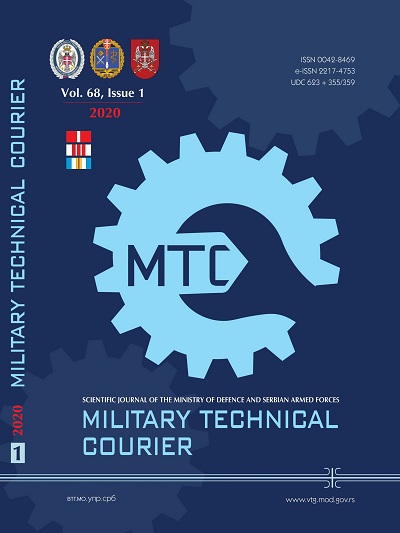Deposition of silica in hydrometallurgical processes
Abstract
Introduction/purpose: Dissolution of nonferrous metals from oxidic ores such as laterite, high silicon bauxite and eudialyte during acidic treatment was connected with silica gel formation.
Methods: Familiarity with behavior of silica in hydrometallugical processes such as dissolution at atmospheric and high pressure, precipitation, neutralization and filtration is most important for the recovery of metals from water solution.
Results:. Gel formation was avoided using dry digestion and a carbonation process of olivine under high pressure in an autoclave.
Conclusion: Fine silica was prepared from olivine in water solution at 175°C and 120 bar for 4 hours in an autoclave using some additives such as sodium bicarbonate and oxalic acid.
References
Alkan, G., Yagmurlu, B., Gronen, L., Dittrich, C., Ma, Y., Stopic, S., & Friedrich, B. 2019. Selective silica gel free scandium extraction from Iron-depleted red mud slags by dry digestion. Hydrometallurgy, 185, pp.266-272. Available at: https://doi.org/10.1016/j.hydromet.2019.03.008.
Béarat, H., McKelvy, M.J., Chizmeshya, A.V.G., Gormley, D., Nunez, R., Carpenter, R.W.,…Wolf, G.H. 2006. Carbon Sequestration via Aqueous Olivine Mineral Carbonation: Role of Passivating Layer Formation. Environmental Science and Technology, 40(15), pp.4802-4808. Available at: https://doi.org/10.1021/es0523340.
Daval, D., Sissmann, O., Menguy, N., Saldi, G.D., Guyot, F., Martinez, I.,…Hellmann, R. 2011. Influence of amorphous silica layer formation on the dissolution rate of olivine at 90°C and elevated pCO2. Chemical Geology, 284(1-2), pp.193-209. Available at: https://doi.org/10.1016/j.chemgeo.2011.02.021.
Eikeland, E., Blichfeld, A.B., Tyrsted, C., Jensen, A., & Iversen, B.B. 2015. Optimized Carbonation of Magnesium Silicate Mineral for CO 2 Storage. ACS Applied Materials and Interfaces, 7(9), pp.5258-5264. Available at: https://doi.org/10.1021/am508432w.
Hansen, T., & Zander, N. 2011. Extraction of silica and magnesium compounds from olivine, European Patent !P 1 373 139 B1.
Kim, K.D., Choi, K.Y., & Yang, J.W. 2005. Formation of spherical hollow silica particles from sodium silicate solution by ultrasonic spray pyrolysis method. Colloids and Surfaces A: Physicochemical and Engineering Aspects, 254(1-3), pp.193-198. Available at: https://doi.org/10.1016/j.colsurfa.2004.12.009.
Ma, Y., Stopic, S., & Friedrich, B. 2019. Hydrometallurgical Treatment of an Eudialyte Concentrate for Preparation of Rare Earth Carbonate. Johnson Matthey Technology Review, 63(1), pp.2-13. Available at: https://doi.org/10.1595/205651318x15270000571362.
Ma, Y., Stopic, S., Gronen, L., Milivojevic, M., Obradovic, S., & Friedrich, B. 2018. Neural Network Modeling for the Extraction of Rare Earth Elements from Eudialyte Concentrate by Dry Digestion and Leaching. Metals, 8(4), p.267. Available at: https://doi.org/10.3390/met8040267.
Nakashima, Y., Takai, C., Razavi-Khosroshahi, H., Suthabanditpong, W., & Fuji, M. 2018. Synthesis of ultra-small hollow silica nanoparticles using the prepared amorphous calcium carbonate in one-pot process. Advanced Powder Technology, 29(4), pp.904-908. Available at: https://doi.org/10.1016/j.apt.2018.01.006.
Olerud, S. 1998. Method for Manufacturing spherical silica from olivine, US Patent 5780005.
Queneau, P.B., Berggren, M.W, Cooperrider, M., & Doane, R.E. 1983. Control of silica deposition during pressure let-down of acidic leach slurries, Hydrometallurgy, Research, Development and Plant Practice. In: 112th AIME Annual Meeting, March 6.
Rahman, I.A., & Padavettan, V. 2012. Synthesis of Silica Nanoparticles by Sol-Gel: Size-Dependent Properties, Surface Modification, and Applications in Silica-Polymer Nanocomposites - A Review. Journal of Nanomaterials, 2012, pp.1-15. Available at: https://doi.org/10.1155/2012/132424.
Rahmani, O., Junin, R., Tyrer, M., & Mohsin, R. 2014. Mineral Carbonation of Red Gypsum for CO 2 Sequestration. Energy and Fuels, 28(9), pp.5953-5958. Available at: https://doi.org/10.1021/ef501265z.
Ratanathavorn, W., Bouhod, N., & Modsuwan, M. 2018. Synthesis of silica nanoparticles by ultrasonic spray pyrolysis technique for cream perfume formulation development. J. Food Health Bioenviron. Sci., 11(3), pp.1-5 [online]. Available at: https://www.tci-thaijo.org/index.php/sdust/article/view/183837. [Accessed: 21 December 2019]
Stopic, S., Dertmann, C., Koiwa, I., Kremer, D., Wotruba, H., Etzold, S.,…Friedrich, B. 2019. Synthesis of Nanosilica via Olivine Mineral Carbonation under High Pressure in an Autoclave. Metals, 9(6), p.708. Available at: https://doi.org/10.3390/met9060708.
Stopic, S., Dertmann, C., Modolo, G., Kegler, P., Neumeier, S., Kremer, D., …Friedrich, B. 2018. Synthesis of Magnesium Carbonate via Carbonation under High Pressure in an Autoclave. Metals, 8(12), p.993. Available at: https://doi.org/10.3390/met8120993.
Stopic, S., Friedrich, B., Schroeder, M., & Weirich, T.E. 2013. Synthesis of TiO2 core/RuO2 shell particles using multistep ultrasonic spray pyrolysis. Materials Research Bulletin, 48(9), pp.3633-3635. Available at: https://doi.org/10.1016/j.materresbull.2013.05.050.
Zulfiqar, U., Subhani, T., & Husain, S.W. 2016. Synthesis and characterization of silica nanoparticles from clay. Journal of Asian Ceramic Societies, 4(1), pp.91-96. Available at: https://doi.org/10.1016/j.jascer.2015.12.001.
Proposed Creative Commons Copyright Notices
Proposed Policy for Military Technical Courier (Journals That Offer Open Access)
Authors who publish with this journal agree to the following terms:
Authors retain copyright and grant the journal right of first publication with the work simultaneously licensed under a Creative Commons Attribution License that allows others to share the work with an acknowledgement of the work's authorship and initial publication in this journal.
- Authors are able to enter into separate, additional contractual arrangements for the non-exclusive distribution of the journal's published version of the work (e.g., post it to an institutional repository or publish it in a book), with an acknowledgement of its initial publication in this journal.
- Authors are permitted and encouraged to post their work online (e.g., in institutional repositories or on their website) prior to and during the submission process, as it can lead to productive exchanges, as well as earlier and greater citation of published work (See The Effect of Open Access).

